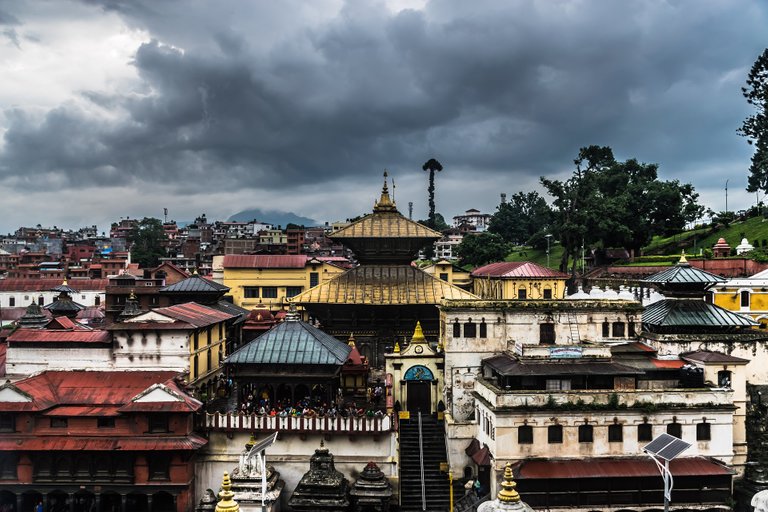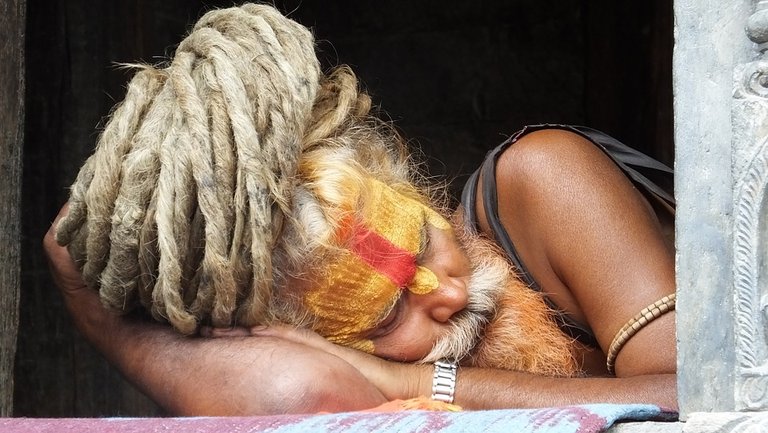
INTRODUCTION::
Pashupathinath is the guardian spirit and the holiest
of all Shiva shrines in Nepal. Lord Shiva is known by many
different names; and Pashupati is one of them. “Pashu” means
living beings, and “Pati” means master. In other words Pashupati
is the master of all living beings of the universe. This is how lord
Pashupati is eulogized in the Vedas, Upnisada and other
religious books. The temple has remained the presiding deity of
ruling Nepalese Royalty. It is located on the banks of the
Bagmati river, this two tiered magnificent golden temple with four
triple silver doorways is unique example of the Nepalese temple
architecture. The temple is famous for its inspiring and astounding pagoda architecture. The
western door has a statue of a large Bull, Nandi, which is ornamented in gold. The black
stone idol, about 6 ft in height and circumference, adds to the beauty and charisma of the
temple.
It is one of the largest Hindu temple complexes in South Asia with hundreds of Shiva
lingams, shrines icons of various Hindu god and goddess insides. This temple site occupies
an area of 281 hectares in total. The main entrance of this temple is in the western side
facing a small street of Deopatan market. Non-Hindus are not allowed to enter the temple
courtyard. They are advised to go on the other side of the river in the East to have a glimpse
of the temple complex. In the middle of the spring there occurs a festival called Shivaratri. The word Shivaratri means the holy night of Lord Shiva. On this day, many devotees visit the
Pashupati Nath temple and make the ceremonial fire. Most of the devotees spend the night
offering prayers to Shiva. This festival attracts tens of thousand of pilgrims from India besides the locals. The site is surrounded with large crowds. The site is overloaded with horns, bells, cows, cars, bicycles, holy men, beggars, smoke, vendors, etc

HISTORY AND HERITAGE VALUE:
Historically pre-Christian era this temple seems to have its srcin away back to the early
Kirat period. Stone sculptures were found in the vicinity, which support the antiquity of this
place. The present architectural nature of Pashupatinath temple came into existence as a
result of renovation by Queen Gangadevi during the reign of Shivasimha Malla during 1578- 1620 AD. King Bhupendra Malla erected the temple again in the 17th century after termites
have consumed the previous building. Further temples have been erected around this two- storied temple. The priests are called “Bhattas” as scribe in sanskrit and the Chief Priest is known
as “Mool Bhatt or Raval” whereas daily worship and other duties of the temple were carried
out by Nepali sanyashi known as “Hermit”. The priests are from south India, srcin since last
350 years. The chief priest is answerable only to the king and reports to him on any temple
matters on a periodic basis. “This tradition is reported to have started by the request of
AdiShankaracharya who sought to unify the different states of unified India by encouraging
cultural exchange.”[1]
The unique feature of this temple is that only 4 priests can touch the deity. “This tradition
is reported to have started by Sage Shankaracharya in 8
th century, ostensibly to stop human
sacrifice which was prevalent in the temple.”[1] However, this tradition was broken after the
historic political revolution in Nepal, which demolished the monarchy. The newly formed
government allowed Nepalese priest to worship by discounting the centuries old tradition.
MYTHOLOGY:
According to a legend recorded in local texts, especially the Nepalamahatmya and the
Himavatkhanda, “the Hindu Lord Shiva once fled from the other gods in Varanasi to
Mrigasthali, the forest on the opposite bank of the Bagmati River from the temple. There, in
the form of a gazelle, he slept with his consort Parvati. When the gods discovered him there
and tried to bring him back to Varanasi, he leapt across the river to the opposite bank, where
one of his horns broke into four pieces. After this, Shiva became manifest as Pashupati (Lord
of Animals) in a four-face (chaturmukha) linga.” [2]
It is said that the wish-fulfilling cow Kamadhenu took shelter in a cave on the Chandravan
mountain. Everyday Kamadhenu went down to the place the lingam was sunken into the soil
and poured her milk on top of the soil. After ten thousand years some people saw
Kamadhenu pouring milk on that same spot everyday, and started to wonder what that would
be. So they removed the soil and found the beautiful shining lingam. After having a good look
they disappeared into the lingam, freed from sin and rebirths. More and more people came to
look and more people disappeared into the lingam.
So guys I will be posting more about Pashupatinath in coming posts. Please upvote and follow me. I am new to this platform so i need encouragement. Thank you :)
Hello,
I need your help to improve my account. I followed your account. can you follow my account?
Hi! I am a robot. I just upvoted you! I found similar content that readers might be interested in:
http://www.nepalheritage.webs.com/culture/pntemple.htm